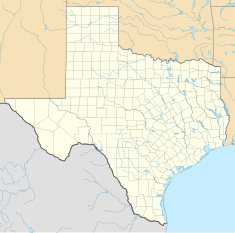
Back Alamo qalası Azerbaijani Alamo BS Alamo German Φρούριο του Άλαμο Greek Misión de El Álamo (Texas) Spanish ایستگاه مبلغان آلامو Persian Alamo Finnish Mission Alamo French Misean Alamo Irish מיסיון אלמו בסן אנטוניו HE
 The chapel of the Alamo Mission is known as the "Shrine of Texas Liberty" | |
| Location | 300 Alamo Plaza San Antonio, Texas U.S. |
|---|---|
| Coordinates | 29°25′33″N 98°29′10″W / 29.42583°N 98.48611°W |
| Name as founded | Misión San Antonio de Valero |
| English translation | Saint Anthony of Valero Mission |
| Patron | Anthony of Padua |
| Founding priest(s) | Antonio de San Buenaventura y Olivare |
| Area | 5 acres (2.0 ha) |
| Built | 1718 |
| Native tribe(s) Spanish name(s) | Coahuiltecans |
| Governing body | Texas General Land Office |
| Criteria | Cultural: (ii) |
| Designated | 2015 (39th session) |
| Part of | San Antonio Missions |
| Reference no. | 1466-005 |
| State Party | |
| Region | Europe and North America |
| Designated | October 15, 1966[1] |
| Reference no. | 66000808[1] |
| Designated | December 19, 1960[2] |
| Designated | July 13, 1977[3] |
| Part of | Alamo Plaza Historic District |
| Reference no. | 77001425 |
| Designated | June 28, 1983 |
| Reference no. | 8200001755 |
The Alamo is a historic Spanish mission and fortress compound founded in the 18th century by Roman Catholic missionaries in what is now San Antonio, Texas, United States. It was the site of the Battle of the Alamo in 1836, a pivotal event of the Texas Revolution in which American folk heroes James Bowie and Davy Crockett were killed.[4] Today it is a museum in the Alamo Plaza Historic District and a part of the San Antonio Missions World Heritage Site.
Originally named the Misión San Antonio de Valero, it was one of the early Spanish missions in Texas, built to convert American tribes to Christianity. The mission was secularized in 1793 and then abandoned. Ten years later, it became a fortress housing the Second Flying Company of San Carlos de Parras military unit, who likely gave the mission the name Alamo ("cottonwood trees"). During the Texas Revolution, Mexican General Martín Perfecto de Cos surrendered the fort to the Texian Army in December 1835, following the Siege of Béxar. A relatively small number of Texian soldiers then occupied the compound for several months. The defenders were wiped out at the Battle of the Alamo on March 6, 1836. As the Mexican Army retreated from Texas several months later, they tore down many of the Alamo walls and burned some of the buildings.
For the next five years, the Alamo was periodically used to garrison soldiers, both Texian and Mexican, but was ultimately abandoned. In 1849, several years after Texas was annexed to the United States, the U.S. Army began renting the facility for use as a quartermaster's depot, before again abandoning the mission in 1876 after nearby Fort Sam Houston was established. The Alamo chapel was sold to the state of Texas, which conducted occasional tours but made no effort to restore it. The remaining buildings were sold to a mercantile company that operated them as a wholesale grocery store.
The Daughters of the Republic of Texas (DRT) formed in 1891 and began trying to preserve the Alamo. Adina Emilia De Zavala and Clara Driscoll successfully convinced the state legislature in 1905 to purchase the remaining buildings and to name the DRT as the permanent custodian of the site. Over the next century, periodic attempts were made to transfer control of the Alamo from the DRT. In early 2015, Texas Land Commissioner George P. Bush officially moved control of the Alamo to the Texas General Land Office.[5] The Alamo and the four missions in the San Antonio Missions National Historical Park were designated a UNESCO World Heritage Site on July 5, 2015.[6]
- ^ a b "National Register Information System". National Register of Historic Places. National Park Service. July 9, 2010.
- ^ Heintzelman (May 1975), National Register of Historic Places Inventory-Nomination:the Spanish Governor's Palace (PDF), National Park Service, retrieved June 22, 2009 and https://npgallery.nps.gov/NRHP/GetAsset/NHLS/66000808_photos (852 KB)
- ^ "Texas Historic Atlas".
- ^ https://www.thealamo.org/visit/whats-at-the-alamo/statues-of-heroes, July 5, 2021.
- ^ , Blanchard, Bobbie. Daughters of the Republic of Texas Sue Land Office, Texas Tribune, March 23, 2015.
- ^ Associated Press. World heritage status for The Alamo, Japan industrial sites, Conroe Courier, July 5, 2015.
